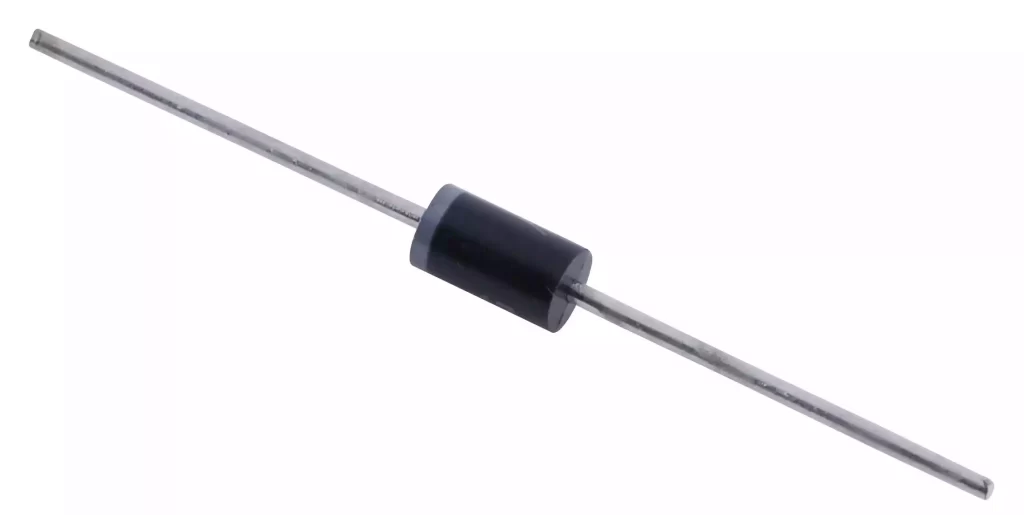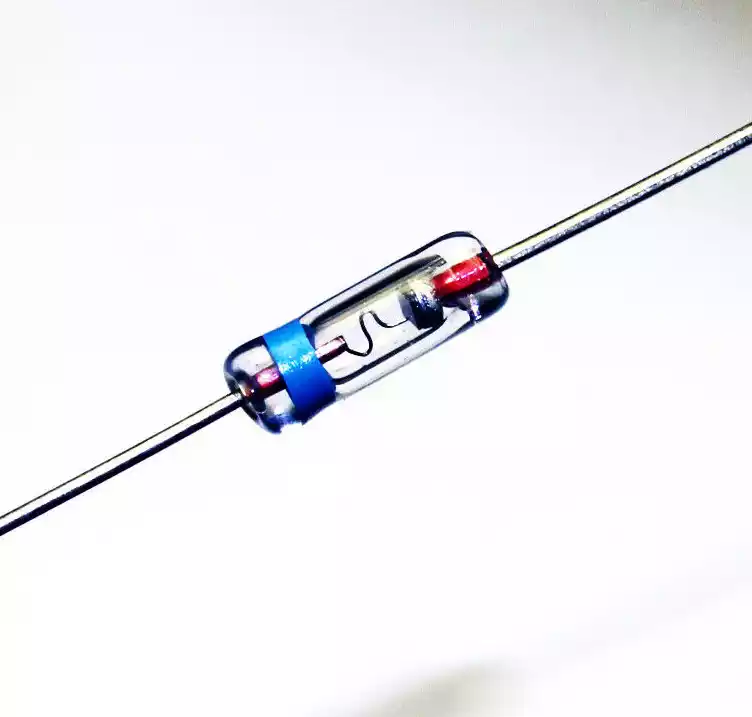Silicon Diode and Germanium Diode are tiny electronic components that control the flow of electricity in circuits. The main difference lies in their materials: silicon is like a strict traffic cop, allowing current to pass only with a higher voltage kick, while germanium is a bit more lenient, requiring less voltage.
Silicon diodes are like reliable, sturdy guards, performing well at higher temperatures and offering stability. On the other hand, germanium diodes are like energetic sprinters, excelling in low-voltage situations but not handling heat as well. Choosing between them depends on the specific needs of electronic devices, as each diode has its strengths and weaknesses.
What is Silicon Diode?
A silicon diode is a tiny but mighty electronic component that plays a crucial role in the world of electronics. Think of it as a traffic cop for electricity! Made from silicon, a special type of material, this diode acts like a gatekeeper, allowing electric current to flow in one direction when a specific amount of voltage is applied.

It’s a bit like a strict bouncer at a party it won’t let just anyone through, you need the right voltage ticket. Silicon diodes are like reliable guardians, handling heat well and providing stability in various electronic devices, including smartphones, computers, and more.
They ensure that the flow of electricity goes where it’s supposed to, contributing to the smooth operation of the gadgets we use every day. In simple terms, a silicon diode is an electronic gatekeeper made of sturdy silicon, ensuring the orderly movement of electrical traffic.
What is Germanium Diode?
A Germanium diode is a small but important player in the world of electronics, serving as a traffic director for electric currents. Picture it as an easygoing guide compared to its Silicon cousin. Crafted from a material called germanium, this diode allows electric current to flow in one direction when a relatively modest amount of voltage is applied.

Unlike Silicon diodes, germanium diodes are a bit more flexible; they require less voltage to get the electrical party started. These diodes are like the laid-back friends at a gathering, letting people in with a lower entry fee.
Germanium diodes have their strengths in lower voltage situations but aren’t as great with high temperatures. They find their niche in certain electronic applications where their specific qualities shine, providing an alternative option to Silicon diodes in certain scenarios.
A Germanium diode is a user-friendly traffic director made of germanium, facilitating the flow of electrical energy with a more relaxed entry requirement.
Key Difference Between Silicon Diode and Germanium Diode
The key differences between Silicon and Germanium diodes:
| Characteristic | Silicon Diode | Germanium Diode |
|---|---|---|
| Forward Voltage Drop | Higher (typically 0.6-0.7V) | Lower (typically 0.3-0.4V) |
| Temperature Sensitivity | Performs well at higher temps | More sensitive to temperature |
| Reverse Leakage Current | Lower | Higher |
| Applications | Widespread, higher voltage | Niche, lower voltage scenarios |
| Band Gap | Larger | Smaller |
| Availability | Abundant | Less abundant |
| Carrier Mobility | Lower | Higher |
| Historical Significance | Less historically significant | Historically significant |
| Common Doping Agents | Boron, Phosphorus | Antimony, Gallium |
Basic Properties of Silicon and Germanium
Silicon and Germanium are like the building blocks of tiny electronic wizards called diodes.
Let’s understand their basic properties in simple terms:
- Atomic Structure: Imagine Silicon atoms holding hands in a very organized line dance, while Germanium atoms do a more laid-back jig. The way they groove together affects how they conduct electricity in gadgets.
- Energy Band Gap: Think of the energy band gap as a dance floor with hurdles. Silicon’s dance floor has higher hurdles, making it a bit strict, while Germanium’s dance floor is more like an open field. It’s like Silicon has a dance with more jumps and twists.
- Conductivity Differences: Now, think of electrons as dance enthusiasts. Silicon is the dance floor manager who needs a loud beat (higher voltage) to get the electrons moving. Germanium, however, is okay with a softer tune, needing less voltage to get the dance party started.
- Heat Endurance: Silicon is like the superhero that doesn’t mind a hot summer day. It can handle high temperatures well. Germanium, on the other hand, prefers a cooler breeze and doesn’t perform as well when it gets too hot.
- Availability in Nature: Silicon is like the popular kid in town, found everywhere, especially in sand. Germanium is a bit rarer, like that cool collectible you find less often.
Electrical Characteristics
Electrical Characteristics of Silicon Diode:
- Forward Voltage Drop: Higher forward voltage drop, requiring more voltage for current flow.
- Temperature Sensitivity: Performs well at higher temperatures, stable under heat.
- Reverse Leakage Current: Exhibits lower reverse leakage currents, minimizing unintended current flow in the off state.
Electrical Characteristics of Germanium Diode:
- Forward Voltage Drop: Lower forward voltage drop, requiring less voltage for current flow.
- Temperature Sensitivity: More sensitive to temperature, may experience performance degradation at higher temperatures.
- Reverse Leakage Current: Tends to have higher reverse leakage currents, leading to increased unintentional current flow in the off state.
How do Silicon Diodes and Germanium Diodes work?
How Silicon Diode Works:
- P-N Junction: Silicon diodes consist of a P-type semiconductor (with positive charge carriers) and an N-type semiconductor (with negative charge carriers) forming a P-N junction.
- Barrier Potential: When a voltage is applied in the forward direction (anode positive, cathode negative), it reduces the barrier potential at the junction, allowing electron flow from N to P, creating a current.
- Reverse Bias: In reverse bias (anode negative, cathode positive), the barrier potential increases, preventing significant electron flow, except for a small reverse leakage current.
- Electron-Hole Recombination: In forward bias, electrons move from N to P, leaving behind positively charged “holes” in the N-type material. The holes combine with electrons in the P-type region, facilitating current flow.
How Germanium Diode Works:
- P-N Junction: Similar to silicon diodes, germanium diodes have a P-N junction formed by a P-type and an N-type semiconductor.
- Lower Barrier Potential: Germanium diodes have a lower forward voltage drop compared to silicon, requiring less voltage to overcome the barrier potential at the junction, allowing current flow.
- Increased Carrier Mobility: Germanium has higher carrier mobility than silicon, facilitating faster movement of charge carriers and making germanium diodes suitable for certain high-frequency applications.
- Temperature Sensitivity: Germanium diodes are more sensitive to temperature changes, and their forward voltage drop decreases with increasing temperature, impacting their performance in warmer environments.
Why are Silicon and Germanium the Best Semiconductors
Germanium and silicon are both thought to be excellent semiconductors due to a variety of reasons.
- Abundance in Nature: Germanium and silicon are the most abundant elements within the Earth’s crust, which makes them a lot of available materials to manufacture semiconductors.
- Crystal Structure: The silicon as well as germanium both have a crystallized lattice structure which allows for effective manipulation of electrons, which contributes to their characteristics as semiconductors.
- Band Gap: The band gap which is the energy gap between conduction and valence bands, is essential to the functionality of semiconductors. Silicon and germanium both have band gaps that are suitable for applications in semiconductors.
- Temperature Stability: The germanium and silicon have stability in semiconductors over the entire temperature range. Particularly, silicon is renowned for its durability even at higher temperatures.
- Purity and Processing: Both substances can be purified to a high degree and the manufacturing processes for germanium and silicon permit precise control of their properties.
- Versatility: The germanium and silicon are easily doped with certain impurities to produce the n-type (electron-rich) and the p-type (hole-rich) semiconductors that allow the creation of many semiconductor devices.
- Reliability: Germanium and silicon are both extensively studied and their properties are well known. This knowledge is a major contributor to the stability and predictability of semiconductor devices constructed from germanium and silicon.
- Historical Significance: Silicon in particular has gained attention due to its widespread use in the semiconductor industry throughout the years. The long-standing technological advancements based on silicon have resulted in a well-established infrastructure as well as a knowledge base.
- Compatible with other materials: Silicon, specifically is usually chosen because of its compatibility with different materials and processes within the electronics industry, which contributes to its widespread adoption.
Applications of Silicon Diode and Germanium Diode
Applications of Silicon Diode:
Common Uses:
- Widely employed in various electronic circuits.
- Found in rectifiers, amplifiers, and signal-processing circuits.
Advantages in Specific Applications:
- Preferred for applications requiring higher temperature tolerance.
- Offers stability and reliability in diverse electronic devices.
Applications of Germanium Diode:
Historical Uses:
- Historically used in early electronic devices and radios.
- Found in vintage electronics and certain niche applications.
Niche Applications:
- Suitable for scenarios where lower voltage requirements are critical.
- Finds use in specific electronic setups, especially those operating in cooler environments.
Advantages and Disadvantages
Advantages of Silicon Diode:
- Higher temperature tolerance.
- Greater stability in electronic circuits.
- Commonly available and widely used.
- Lower forward voltage drop in comparison to some other materials.
Disadvantages of Silicon Diode:
- Higher forward voltage drop compared to germanium diodes.
- Limited performance in low-temperature environments.
Advantages of Germanium Diode:
- Lower forward voltage drop.
- Better performance at lower temperatures.
- Historical significance in early electronic devices.
- Suitable for specific applications with lower voltage requirements.
Disadvantages of Germanium Diode:
- Higher reverse leakage currents.
- Limited availability compared to silicon diodes.
- Sensitivity to higher temperatures, affecting performance.
How do Silicon and Germanium diodes differ in terms of forward voltage drop?
Silica and Germanium diodes differ significantly in the sense of their voltage decline forward, which is an important parameter that affects how they perform in circuits made of electronics. The diodes that are made of silicon usually have more of a drop in forward voltage that typically ranges between 0.6 to 0.7 Volts.
The higher voltage requirement can be due to the wider band gap in silicon. The band gap is the energy required to transfer electrons out of the valence band into the conduction band, which allows the flow of current.
Contrary to this, Germanium diodes have a lower drop in forward voltage generally around 0.3 to 0.4 Volts due to their lower band gap.The narrower band gap of Germanium permits for a more efficient transfer of electrons across the junction, requiring less energy to begin the flow of electrons.
Therefore engineers and circuit makers select between germanium and silicon diodes according to particular application requirements, taking into account things like voltage restrictions as well as temperature sensitivity and general efficiency.
summary
A Germanium diode is a small electronic component that regulates electric currents, acting as a more lenient counterpart to the Silicon diode. Crafted from germanium material, it permits current flow with lower voltage requirements, resembling a laid-back guide at an electric party.
Unlike Silicon diodes, Germanium diodes excel in lower voltage scenarios but are less effective in high-temperature environments. They find specific applications where their unique qualities are advantageous, offering an alternative to Silicon diodes in certain electronic setups.
Essentially, a Germanium diode is a user-friendly traffic director made of germanium, facilitating electrical energy flow with a more relaxed entry requirement compared to its Silicon counterpart.






























